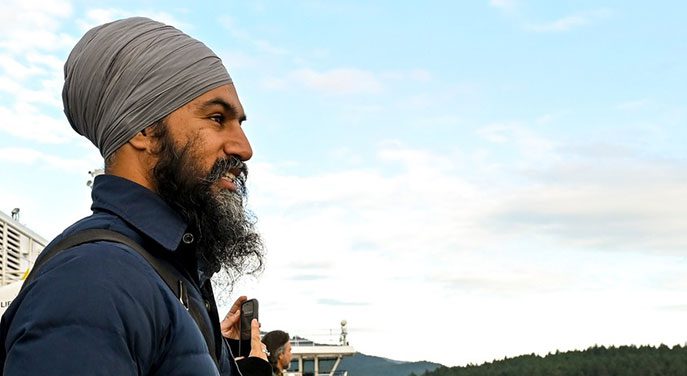 Could the Liberal-NDP agreement actually collapse if a proposed national dental plan for low-income Canadians isn’t implemented by year’s end?
Could the Liberal-NDP agreement actually collapse if a proposed national dental plan for low-income Canadians isn’t implemented by year’s end?
That’s what NDP Leader Jagmeet Singh reportedly threatened to do.
The national dental plan was one of the centrepieces of the three-year agreement when it was signed by Singh and Liberal Prime Minister Justin Trudeau in March. Children of low-income families – defined as having an annual income of under $90,000 – would be eligible to receive subsidized dental care. Families earning less than $70,000 a year wouldn’t have to make co-payments and would be fully covered by the government.
Children under 12 would be eligible for the low-income dental plan in 2022. Coverage would be extended to 18-year-olds, seniors and individuals with disabilities in 2023, and the entire program would be in place by 2025.
The NDP geared this policy promise toward 6.5 million uninsured Canadians during the 2019 and 2021 elections. It failed to resonate with voters, who recognize most NDP policies are a combination of fantasy, conjecture and fiscal irresponsibility.
The Parliamentary Budget Officer estimated in an Oct. 7, 2020, report that the NDP dental plan would cost $1.4 billion during the 2020-21 fiscal year. It would escalate to $4.6 billion in 2021-22, then average $1.7 billion a year between 2022-23 and 2024-25.
Singh was ultimately able to sell his socialist fantasy to Trudeau, another left-leaning politician who has intimate experience with fantastical ideas and wasteful spending of taxpayer dollars.
Now the chickens are coming home to roost.
|
|||
|
“I made it really clear to the prime minister directly that this has to happen,” Singh told Toronto Star columnist Althia Raj recently. “There’s just no option for them. This has to happen. The deal stands on this. … We have no room for any error; we’ve no room for any exception.”
The NDP leader also said “the $500 housing top-up for those that get the Canadian Housing Benefit, that has to get out the door” this year. He said it was something he was “very firm about in my meeting with the prime minister.” The Liberals “just don’t have a choice” but to go along with his demands.
Why is the agreement’s junior partner so adamant about ensuring these two policies move forward?
Part of this is to force Trudeau’s hand to meet his political obligations. If the PM won’t meet promises made to the NDP, his working relationship with Singh isn’t worth the paper it was written on. This makes perfect sense.
The NDP is also trying to distinguish itself from the Liberals as the only party Canada’s political left can trust. If the NDP makes proposals for this agreement and the Liberals only pay lip service to them, it should be obvious who’s really thinking about progressive policies and ideas. Again, it makes sense from a strategic standpoint.
Every other part of this equation doesn’t make a lick of sense, however.
If the agreement ends in 2022, the Liberal government will fall in short order. Most opinion polls since February show the NDP below 20 per cent of popular support. The party reportedly spent $24 million on last year’s election campaign, struggled mightily to pay that off and has been in financial straits ever since. The NDP simply couldn’t run an effective election campaign next year.
Some NDP supporters have expressed concerns about Singh’s leadership for years. Quite a few denounced his decision to sign any sort of agreement with Trudeau to keep him afloat, irrespective of their support for specific policies. That’s not going to entice more left-leaning Canadians to vote for him.
Anyone who believes disgruntled Liberals would automatically vote for a Singh-led NDP is fooling themselves, too. He’s lost two straight federal elections and hasn’t made any significant gains. If another person was at the helm, that’s one thing. But if Singh remains, they’ll either hold their noses and vote Conservative, support the Greens or Bloc Quebecois (depending where they live), or stay home.
The reason for ending the Liberal-NDP arrangement is extremely flimsy.
If failing to implement a national dental plan triggers a federal election in 2023, Trudeau will receive some of the blame. But most Canadians will point at Singh, which could lead to a drop in popular support for the NDP – which stood at only 17.82 per cent in 2021 – and reduce their 25 seats.
The estimated cost of the 2021 election was an eye-popping $630 million, according to Elections Canada, and accomplished nothing.
Does the NDP really want to wear this massive albatross on its neck?
You wouldn’t think so. Then again, maybe it does.
Michael Taube, a Troy Media syndicated columnist and Washington Times contributor, was a speechwriter for former prime minister Stephen Harper. He holds a master’s degree in comparative politics from the London School of Economics.
For interview requests, click here.
The opinions expressed by our columnists and contributors are theirs alone and do not inherently or expressly reflect the views of our publication.
© Troy Media
Troy Media is an editorial content provider to media outlets and its own hosted community news outlets across Canada.


